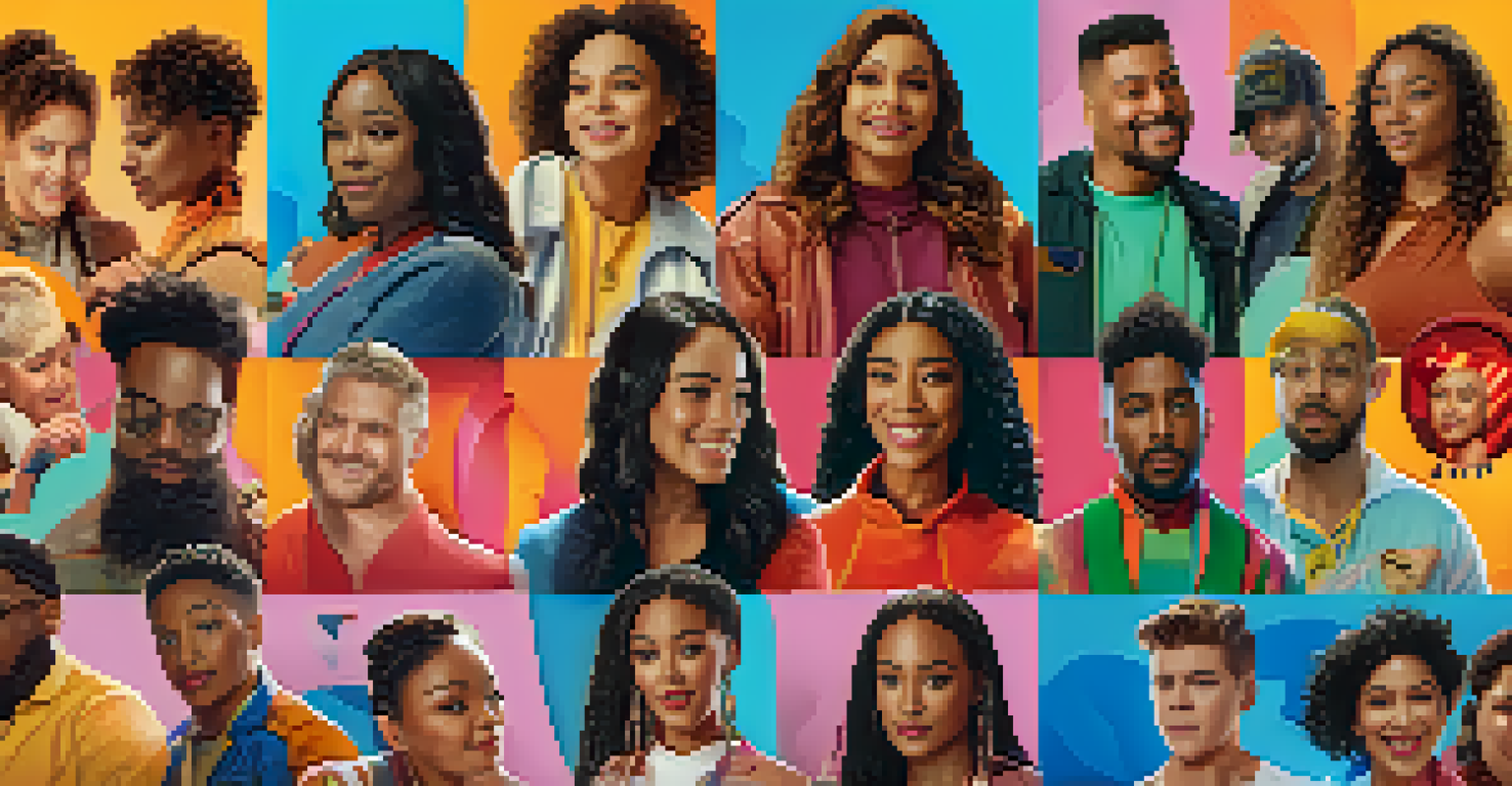The Role of Marketing in Gender Representation in Film

Understanding Gender Representation in Film Marketing
Gender representation in film is not just about the characters we see on screen; it starts long before the lights come up. Marketing plays a crucial role in how films are perceived, influencing audiences' expectations and engagement. When films are marketed, the way genders are portrayed can significantly affect societal norms and attitudes.
Marketing is not just a tool for promotion; it is also a powerful medium that shapes cultural narratives around gender.
For example, a film that highlights strong female leads may be marketed as a groundbreaking story, emphasizing empowerment. This not only attracts viewers but also challenges existing stereotypes. Conversely, if a film leans heavily on traditional gender roles in its marketing, it risks perpetuating outdated narratives.
Thus, understanding how marketing strategies align with gender representation can reveal much about the film's broader impact on culture. It's essential to unpack these strategies to see how they contribute to or challenge gender norms in our society.
The Influence of Target Audiences on Film Marketing
Film marketing often targets specific audiences based on demographics, interests, and social trends. This targeting can significantly influence how gender roles are portrayed and perceived in trailers, posters, and advertisements. For example, a film aimed at younger audiences may feature diverse characters and narratives, aligning with their values of inclusivity.

On the other hand, a film targeting a more traditional audience might rely on established gender norms that reinforce stereotypes. This targeting can ultimately dictate the film's financial success and cultural relevance, showcasing the power of marketing in shaping gender representation.
Marketing Shapes Gender Norms
Film marketing significantly influences societal perceptions of gender roles and can either challenge or reinforce stereotypes.
Thus, understanding the influence of target demographics on marketing strategies helps to reveal the broader implications for gender representation in cinema. It becomes clear that who is being marketed to can shape not only box office numbers but also societal perceptions.
Marketing Campaigns: Case Studies of Gender Representation
Examining specific marketing campaigns can provide insights into the role of gender representation in film. For instance, the marketing strategy for 'Wonder Woman' heavily emphasized female empowerment and was designed to resonate with women and young girls. This approach not only attracted audiences but also sparked conversations about female representation in superhero films.
As audiences continue to demand authenticity and representation, the pressure is on marketers to adapt their strategies accordingly.
In contrast, the marketing for some action films may rely on hypermasculine imagery, appealing to traditional male audiences. These contrasting campaigns demonstrate how marketing decisions can either challenge or reinforce gender stereotypes. By analyzing these case studies, we can better understand the direct impact of marketing on gender portrayal.
These examples illustrate that marketing is not just a tool for promotion; it is also a powerful medium that shapes cultural narratives around gender. As audiences become more discerning, the effectiveness of these campaigns in addressing gender representation becomes increasingly vital.
Social Media's Role in Shaping Gender Representation
In today's digital age, social media plays an integral role in film marketing and gender representation. Platforms like Instagram, Twitter, and TikTok allow for direct engagement with audiences, enabling films to create buzz and conversation around their gender narratives. This engagement can either bolster or undermine traditional gender roles, depending on how the content is presented.
For instance, films that promote strong female characters or diverse casts often utilize social media to highlight these aspects, attracting a broader audience. Conversely, films that perpetuate stereotypes may face backlash on these platforms, leading to calls for more authentic representation. This dynamic creates a feedback loop where audiences can influence marketing strategies in real time.
Target Audiences Drive Representation
The demographics and interests of target audiences heavily dictate how gender is represented in film marketing.
As social media continues to evolve, its role in shaping perceptions of gender in film marketing will become increasingly significant. It serves not only as a promotional tool but also as a platform for advocacy and change.
The Impact of Cultural Trends on Marketing Strategies
Cultural trends play a pivotal role in shaping film marketing strategies, particularly regarding gender representation. As society progresses toward inclusivity and equality, marketing campaigns are increasingly reflecting these values. For example, the rise of feminist movements has prompted films to showcase complex female characters, which is often highlighted in their marketing.
Conversely, films that ignore these cultural shifts may find themselves criticized and underperforming at the box office. The disconnect between societal values and marketing strategies can lead to significant backlash from audiences demanding greater representation. By keeping a pulse on cultural trends, marketers can create campaigns that resonate with audiences and reflect contemporary values.
Understanding the relationship between culture and marketing strategies is key to driving meaningful change in gender representation. As marketers adapt to shifting norms, they have the opportunity to redefine narratives and promote more equitable portrayals.
Challenges in Achieving Gender Equality in Film Marketing
Despite progress, challenges remain in achieving gender equality in film marketing. Often, decision-makers in marketing departments may still hold traditional views on gender roles, influencing the campaigns they create. This can result in missed opportunities to showcase diverse narratives and characters that resonate with modern audiences.
Additionally, there can be a tendency to revert to tried-and-true formulas that prioritize male characters or draw on stereotypes, limiting the scope of representation. The challenge lies not only in recognizing these issues but also in actively working to change them within the industry. It requires a concerted effort from marketers, filmmakers, and audiences alike to demand more inclusive narratives.
Social Media Amplifies Gender Issues
Social media platforms play a crucial role in shaping conversations around gender representation in film, impacting marketing strategies in real time.
Addressing these challenges head-on is essential for fostering an environment where gender representation in film marketing can thrive. By pushing for change, we can help ensure that all voices are heard and represented on screen.
The Future of Gender Representation in Film Marketing
Looking ahead, the future of gender representation in film marketing appears promising yet complex. With increasing awareness and advocacy for diverse representation, filmmakers and marketers are recognizing the importance of inclusive narratives. This recognition could lead to more films featuring women and non-binary individuals in leading roles, reflected in their marketing strategies.
As audiences continue to demand authenticity and representation, the pressure is on marketers to adapt their strategies accordingly. This shift may involve breaking away from traditional stereotypes and embracing stories that reflect a wide range of experiences and identities. The industry is at a turning point where the demand for change is louder than ever.

Ultimately, the relationship between marketing and gender representation in film will shape the stories we see on screen. By prioritizing diversity and inclusivity, the future can pave the way for more authentic narratives that resonate with a broader audience.